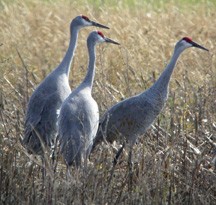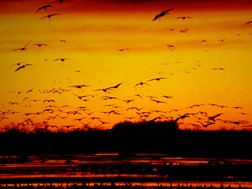Trumpeting Sandhill Cranes
- Share
- Tweet
- Pin
- Share
“This exquisite weather…I enjoy it all over me, from top to toe, longitudinally, perpendicularly, diagonally.” ~ Jane Austen

These cranes, photographed on October 25, 2004, are fattening up for their flight to perhaps Jasper-Pulaski State Wildlife Area in Indiana.
With tongue in cheek I maintain this is one of many times during the year that it would require the combined strength of a team of strong draft horses to pull me away from Door County. To awaken before sunrise and watch the sun gradually light up the spectacular Sugar Maples and other trees, highlighted against a brilliant azure sky, and then hear in a neighboring field the clarion trumpeting calls of Sandhill Cranes, as though they are ecstatically dancing at dawn’s early light, bugling and greeting the new day – gosh, how much better could it get?
We dearly love the cranes, believed to be one of the oldest living bird species on earth. The great Aldo Leopold said it to perfection: “The quality of cranes…lies beyond the reach of words.” Fortunately for millions of other people, these spectacular creatures are one of the most widely distributed birds occurring on the North American continent.
In the early 1930s fewer than 25 pairs of Sandhill Cranes were thought to exist in Wisconsin, primarily due to the settling of the state and the destruction of the cranes’ marshland habitat. Gradually, through widespread education, along with the restoration and protection of wetlands, the crane population rebounded to where, today, about 12,000 pairs of the Sandhills nest in our state. Fortunately, over the past 100-plus years the habitat of these birds has gradually changed from wilderness to countryside. They have adapted their lives to feed in pastures and cornfields instead of prairies.
Charlotte and I were lucky to see only one Whooping Crane in our lives, a single bird in with a flock of a few hundred Sandhill Cranes in a stubble cornfield a mile or so east of the Horicon National Wildlife Reservation. How exciting it was to observe the world’s most highly threatened crane, the Whooping Crane, in with the world’s most abundant crane, the Sandhill Crane. Sadly, of the world’s 15 species of wild cranes, 11 are listed as threatened today.

Thousands of Sandhill Cranes were photographed in March 1995 along the Platte River in Nebraska.
Are there threats to these cranes in the Upper Midwest today? Yes. Unfortunately there are growing numbers of humans who seek the same solitude and seclusion as do the cranes. Some farmers are experiencing increasing problems with the cranes feasting on newly planted corn. Fortunately those in the seed business are working to develop ways of overcoming this problem.
Crane hunting is another complicated issue, producing great polarity between the hunters and non-hunters. More than a dozen mostly western states (including Texas where the most cranes are shot each year) allow crane hunting. I would hate to see this become a “political football” in Wisconsin where, I personally feel, much more solid research must be done before allowing an annual hunt. I prefer to remain on the conservation rather than the political side of the matter.
I recall with great fondness the small groups of Wisconsin Rapids junior high students I took – a carful at a time on early Saturday mornings during the late 1950s – to some sprawling marshes in Wood County in the Adams-Friendship area to witness the clear, shrill, trumpeting notes – “gaROOO-a-a-a” – of several dozen Sandhill Cranes. The students’ first impression of the weird, rattling, gargling, haunting but wonderful music, which easily carries a mile or more, was that it belonged somewhere in the middle of a jungle. I can’t imagine developing a real feel for the cranes, their ways, their music, within the confines of the four walls of a classroom. One simply must absorb this awesome spectacle first hand.
Charlotte and I have had the good fortune of visiting three of the finest preserves in the Midwest and West to revel at the site of thousands of Sandhills. The first was at the especially excellent Bosque del Apache National Wildlife Reservation south of Albuquerque, then Socorro, and then to the small town of San Antonio in New Mexico. There are numerous sites to observe, via well-designed auto routes, hiking trails and from observation blinds and towers, the cranes, geese, small waterfowl and other wildlife.
We planned a year ahead for our trip in mid-March to a renowned Platte River crane refuge in Nebraska to witness one of the most incredible bird phenomena in the world, a site where one can come to within 50 yards of a build-up of 20,000 Sandhill Cranes. Can you imagine the cacophony, the unbelievable spine-tingling thrills being so close to this annual early spring migratory ritual?
We reserved places in both an early morning and evening viewing blind along the river at the National Audubon Society’s Rowe Sanctuary near Kearny. It is a large blind holding a few dozen watchers who, either standing or sitting, can view and photograph through multiple small openings without being detected by the large birds. You enter the blind in the late afternoon before the cranes arrive.
If you’re lucky, as we were, observing and photographing the cranes against a flaming red sunset can be a once-in-a-lifetime experience. It is when darkness arrives and the birds have settled down for the night in the safety of the shallow water that the group of watchers stealthily and silently leaves the blind.
We were back into that same blind well before sunrise the following morning to watch the cranes awaken, preen and prepare to head out to adjacent fields to loaf and feed. Believe me, this experience will remain in our hearts and minds for a long time.

Cranes in a Door County cornfield are getting ready for their southerly migration.
From mid-October to mid-December, with the peak build-up of cranes occurring in mid-November, is the time to come close to upwards of 10,000 Sandhill Cranes at the Jasper Pulaski State Wildlife Area in northern Indiana. Usually these birds eventually migrate southward to spend the winter, perhaps as far as Texas. However, during the rather snowless winter there in 2001-2002, nearly 10,000 Sandhills found good feeding and remained for the duration of the cold months before migrating back northward the following spring, presumably some of them to nest in Door County!
We watched and photographed the spectacle at sundown from an easy-to-find raised open viewing platform with a number of other people. Amazingly the birds were very tolerant of being watched, with some of the cranes as close as 50 yards from the platform.
Some cranes remain in Door County until mid-November, so get out and enjoy this “Call of the Wild” spectacle while it lasts. I continue to marvel, over the past 48 years, at the appearance of what I think is an increasing number of Sandhill Cranes in this region in light of what also appears as a never-ending pace of development. Deep down I feel that these cranes are trumpeting a loud-ringing far-reaching message: “Save, protect, preserve! Please help us!”

